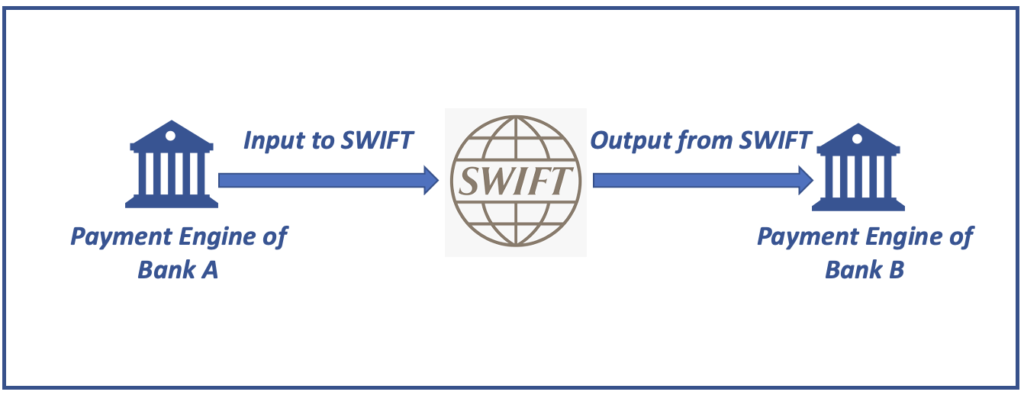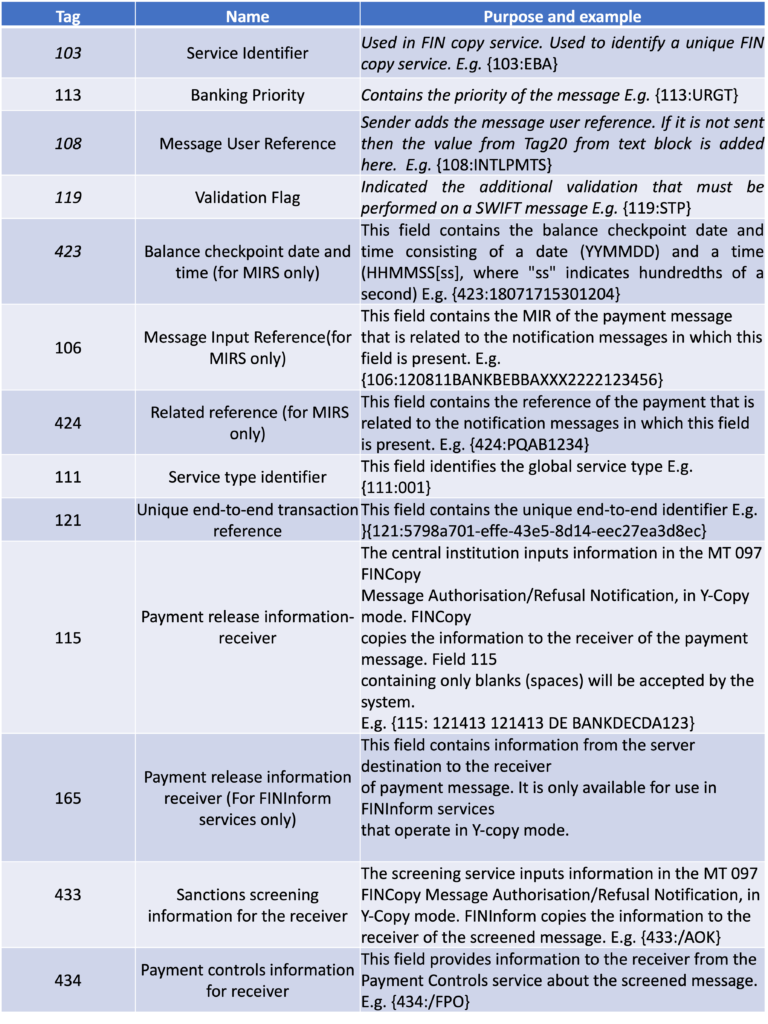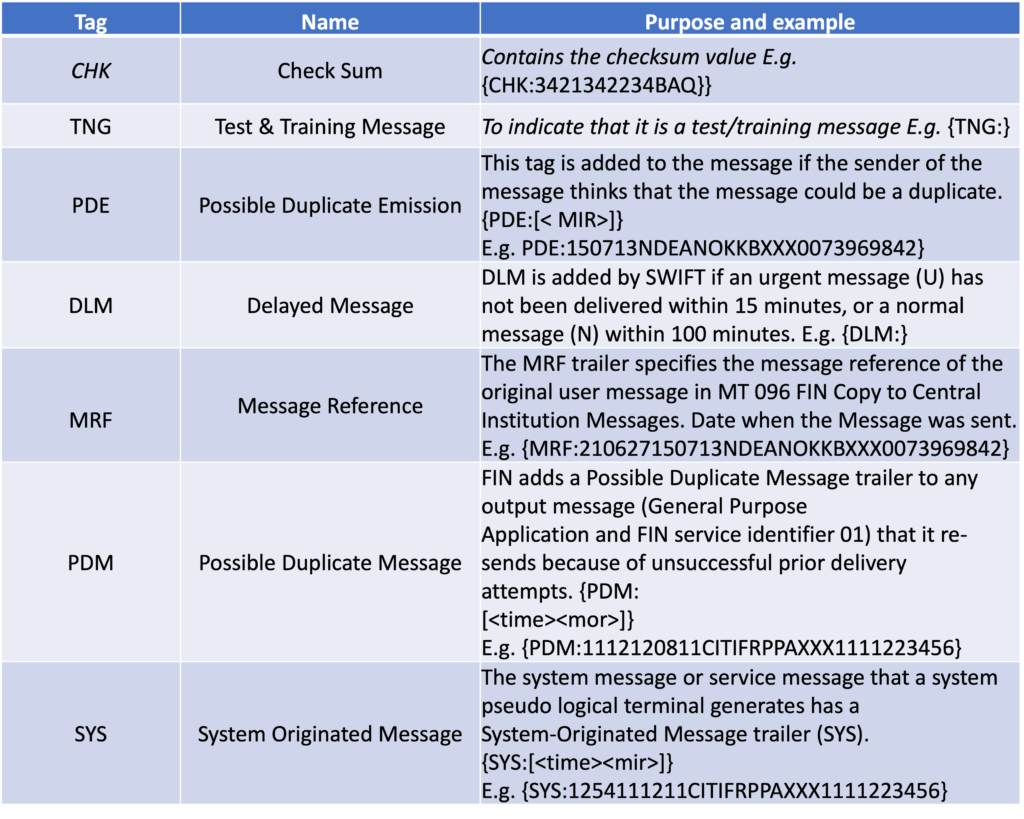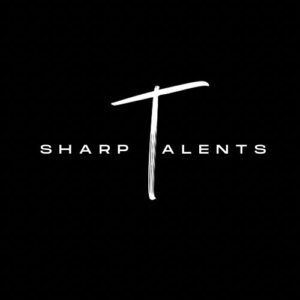SWIFT MTs – Blocks 1 Through 5
We have discussed in our previous article that there are 5 blocks in a SWIFT MT message. Now we will dive deep into each of these blocks and try to understand them in detail. Please save this page for your future reference (At least till 2025)
There are some common details and we will try to understand what they are
- All the blocks start with “{”
- The Block number or block identifier will be displayed at the very beginning followed by a “:” (Separator)
- This will be followed by the contents of the block
- The block will end with a “}”
Basic Header Block (Block 1 )
This block is the only mandatory block and contains general information identifying a message. Let us now dissect the block
{1:F01CITIFRPPAXXX0070970817}
This can be split into different components ( Split using spaces)
{ 1 : F 01 CITIFRPPAXXX 0070 970817}
F – This is application Identifier or AppID . F Indicated that it is a FIN message
01 – This is the service identifier and it consists of 2 digit numbers. 01 indicated that it is FIN. 21 stands for an acknowledgment (ACK) or negative acknowledgment (NACK)
CITIFRPPAXXX – This is a very interesting one. Technically it is called the LT address. It can be further split into the following
CITIFRPP – Bank BIC
A – Terminal ID
XXX – Bank branch code (Part of the BIC)
So the 11 character BIC would be CITIFRPPXXX . This BIC is the sender of the message if the First char of Block 2 is “I” and it indicates the receiver if Block 2 is “O” . We will see what the O and I mean very soon.
0070 – It is the session number of FIN
970817 – The 6 digit number is the sequence number. This is not very interesting from a functional point of view hence will skip it. If you are interested in knowing the details please let me know I will add the details in this article.
Application Header Block (Block 2)
The application header contains information that is specific to the application. The application
header is required for messages that users, or the system and users, exchange. The application header contains information that is specific to the application. The application
header is required for messages that users, or the system and users, exchange.
Example:
{2:O1031734150713NDEANOKKBXXX00739698421607131634N}
The application Header block can once again have two types
- Application Header Block for Input messages
- Application Header Block for Output messages
You might very well ask ‘what does “Input” and “Output” mean ??’
“Input” means input TO SWIFT
“Output” means output FROM SWIFT
When payment engines of the sender bank generate SWIFT payments then they will Input the message to SWIFT network, the message will then be output from SWIFT network which will then be consumed by the receiver bank

Application Header Block for Input messages
{2:I103NDEANOKKBXXXU3003}
This can be segregated into the different components as follows
I 103 NDEANOKKBXXX U 3 003
I – Input to SWIFT network
103 – SWIFT MT message
NDEANOKKBXXX – This is the Destination address to which this payment is addressed. It contains 12 characters – 11 Char BIC + 1 Char Logical terminal
NDEANOKKXXX – 11 Char Bic
B – Which is the 9th character is the Logical terminal code
U – This is the message priority. “U” stands for Urgent. The other possible values are S (System) and N ( Normal). The “S” is for user to system messages.
3 – It indicates the delivery monitoring option and is applicable for FIN-type messages.
The chosen option is expressed as a single digit:
- 1 = Non-Delivery Warning
- 2 = Delivery Notification
- 3 = Non-Delivery Warning and Delivery Notification
If the message has priority ‘U’, the user must request delivery monitoring option ‘1’ or ‘3’. If the message has priority ‘N’, the user can request delivery monitoring option ‘2’ or, by leaving the options blank, no delivery monitoring.
003 – Obsolescence Period mentions the amount of time after which the delayed message (DLM) trailer is added to a FIN user-to-User message or if it is a Urgent message then it is the amount of time after which the message can be marked Not delivered and a warning message is sent.
Each unit has a value of 5 minutes so,
003 – 15 mins (Urgent)
020 – 100 mins (Normal)
Application Header Block for Output messages
{2:O1031734150713NDEANOKKBXXX00739698421607131634N}
This can be segregated into the different components as follows
O 103 1734 150713NDEANOKKBXXX0073969842 160713 1634 N
O – Output to SWIFT network
103 – SWIFT MT message
1734 – The local Input time in the format (HHMM)
150713NDEANOKKBXXX0073969842 – This is the message input reference this can be further split the following
150713 – Date in YYMMDD format
NDEANOKKBXXX – Logical terminal address of the sender of the message ( 8 Char BIC + Logical terminal code + 3 digit branch code of the BIC)
NDEANOKK B XXX
0073 – Session number
969842 – Sequence number
160713 – Output date
1634 – Output Time
N – Priority. N stands for normal and U for Urgent.
Use header Block (Block 3)
The user header block is common to all swift messages and is used in certain situations. This block contains information in different tags and these tags are available between 2 curly brackets.
{3:{113:URGT}{108:INTLPMTS}{121:5798a701-effe-43e5-8d14-eec27ea3d8ec}}

Text Block (Block 4)
This block contains the contain the main content of the message that includes amounts, value dates, charges, etc.
The contents of each type of message widely vary and the best place to view the details of the SWIFT MT message is SWIFT’s official website. It contains details of all the swift messages.
Link:
https://www2.swift.com/knowledgecentre/products/Standards%20MT/publications#November%202021
We will discuss some of the text blocks of some of the messages in future articles.
Trailer Block (Block 5)
The trailer either indicates special circumstances that relate to message handling or contains security information.
{5:{CHK:D628FE016232}}

SOURCEs ( Thanks to them):
https://www.ibm.com/docs/en/ftmfz/3.2.5?topic=messages-user-header-block-block-3-sr-2017




Blog Comments
Chandan
November 20, 2021 at 7:35 am
Hi Santosh.
Thank you for the post. This is really helpful for people who wants to start payment from basic.
Your example clearly illustrates how message are structured and what does Input to swift and output to swift mean.
{2:I103NDEANOKKBXXXU3003} – Here BIC belongs to receiver Bank.
{2:O1031734150713NDEANOKKBXXX00739698421607131634N- Here BIC refers to sender Bank.
When I is updated with O ,BIC also changes it position between Block 1 and 2.
Please confirm if my understanding is correct . If Yes, then it may be worth mentioning in your article so people are also aware of this.
I am just a learner not an expert so please excuse me if I mentioned something wrong.
Santosh
November 20, 2021 at 3:35 pm
Your understanding is correct but I have tried to explain how the input and output messages are different. May be this comment will help people understand.
Chandan
November 21, 2021 at 12:45 pm
Thanks.